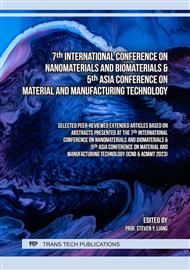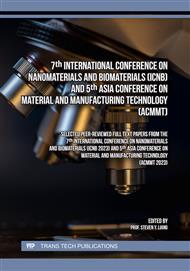p.3
p.9
p.15
p.21
p.27
p.35
p.41
p.47
Comparison of Organic and Inorganic - Modified Halloysite Nanotube for Improved Drug Delivery of Aspirin
Abstract:
Halloysite nanotubes (HNTs), the naturally formed mineral clays with hollow tubular structures, have found promising applications as nanocarriers for drug delivery systems due to their biocompatibility and nontoxicity. By modifying the lumen of HNT, drug delivery of various types of sensitive and low-dissolution drugs could be enhanced. This study presents a comparison of the properties of modified HNTs containing an organic modifier (Sodium Laureth Sulfate, SLES) and an inorganic modifier (Sodium Thiosulfate, STS) as carriers of a slightly water-soluble drug, aspirin. HNTs modified by STS showed higher negative zeta potential than those modified by SLES, indicating that STS-modified HNTs are relatively more stable. The negative zeta potential of STS-modified HNT however decreased upon aspirin loading while that of SLES-modified HNT increased, implying that aspirin interacts with the modifiers differently. In terms of drug release, both modified HNTs showed an improved aspirin release rate compared with pure HNT. Moreover, the STS-modified HNT showed a higher aspirin release (21.5%) in the first hour but the SLES-modified HNT showed the highest cumulative release of 62.5% after 6 hours. These results therefore show that the developed modified HNTs improve the release of aspirin and demonstrate how the nature of the modifier (organic or inorganic) on the HNT lumen affects the behaviour of the drug release of aspirin. This also gives an avenue for modulating drug release based on certain requirements such as time and quantity of drug released.
Info:
Periodical:
Pages:
15-20
Citation:
Online since:
March 2024
Price:
Сopyright:
© 2024 Trans Tech Publications Ltd. All Rights Reserved
Share:
Citation:



